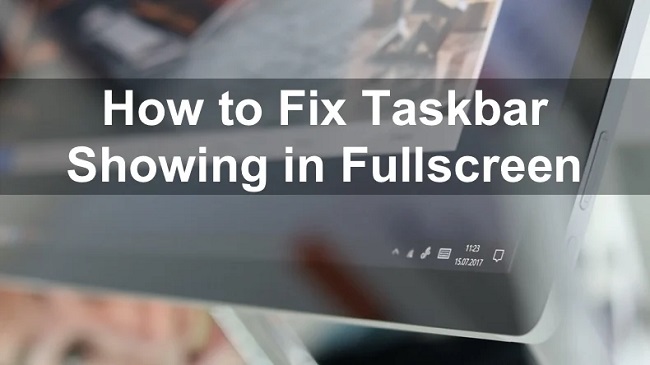Having a full-screen taskbar on your Windows 10 computer can be annoying. It obstructs the view of your desktop and interferes with full-screen applications. If you’re in this predicament, don’t worry.
This article explores the causes and offers detailed solutions to fix the problem of the taskbar showing in full screen.

The Causes Behind the Taskbar Showing in Full Screen
The taskbar showing up in full screen could be due to a myriad of reasons. Here are a few:
- Windows Settings: Windows has settings to automatically hide the taskbar in desktop mode or tablet mode. If these settings aren’t enabled, the taskbar can show up in full screen.
- Application Settings: Some applications might override system settings, causing the taskbar to show up in full screen.
- Taskbar Settings: The taskbar settings might be corrupted, leading to this issue.
Foolproof Solutions to Fix Full-Screen Taskbar Problem
Solution 1: Auto-hide the Taskbar
The quickest fix for a full-screen taskbar issue is to set it to auto-hide. Here’s how:
- Right-click on the taskbar and select ‘Taskbar settings’.
- Under the ‘Taskbar’ section, turn on the option for ‘Automatically hide the taskbar in desktop mode’.
- If you’re using a tablet, enable the ‘Automatically hide the taskbar in tablet mode’ option.
If the taskbar is still visible in full screen, move on to the next solution.
Solution 2: Change App Settings
Some apps, like YouTube or VLC media player, have their own full-screen settings. If these are overriding your system settings, changing them can resolve the issue. This process will differ for each app, but generally, you’ll find this option in the app’s settings or preferences.
Solution 3: Restart Windows Explorer
Restarting Windows Explorer can often fix minor glitches with the taskbar. Here’s how:
- Press ‘Ctrl + Shift + Esc’ to open the Task Manager.
- Find ‘Windows Explorer’ in the list and select it.
- Click ‘Restart’ at the bottom-right of the window.
Solution 4: Perform System Maintenance
Performing system maintenance can fix underlying issues that might be causing the problem.
- Press ‘Win + X’ and select ‘Control Panel’.
- Click ‘Find and fix problems’ under ‘System and Security’.
- Follow the prompts to run the maintenance.
Conclusion
Your taskbar should ideally facilitate easy navigation without obstructing full-screen activities. When it becomes a hindrance, as in the case of a full-screen taskbar, it’s essential to address the issue promptly.
The detailed causes and solutions outlined in this guide should help you overcome this minor yet disruptive issue, restoring your Windows 10 user interface to its optimal functioning.
Remember, regular system maintenance and vigilance about individual app settings go a long way in preventing such issues from reoccurring.
Frequently Asked Questions
Here are some of the frequently asked questions to this topic:
1. Why does my taskbar not hide when I go fullscreen in Windows 10?
The taskbar may not hide in fullscreen due to incorrect configuration of Windows settings, application settings, or corrupted taskbar settings. Follow the detailed solutions mentioned in the article to rectify the issue.
2. How do I get my taskbar to hide in fullscreen mode?
You can get your taskbar to hide in fullscreen mode by setting the taskbar to auto-hide in the Windows settings. If that doesn’t work, try adjusting the fullscreen settings in the individual app or restart Windows Explorer.
3. Can specific applications prevent my taskbar from hiding?
Yes, some applications have independent fullscreen settings that may override the system settings, forcing the taskbar to remain visible. Adjusting these settings in the specific application can help resolve the issue.
4. Is it normal for the taskbar to appear in fullscreen mode?
The taskbar should ideally auto-hide when an application is in fullscreen mode. If it doesn’t, it’s usually due to a settings issue that can be resolved by following the steps outlined in the article.
5. Does restarting Windows Explorer always fix the fullscreen taskbar problem?
Restarting Windows Explorer can fix the issue if it’s due to a glitch in the system. However, if the problem lies within Windows or app settings, you may need to try the other solutions provided in the article.


